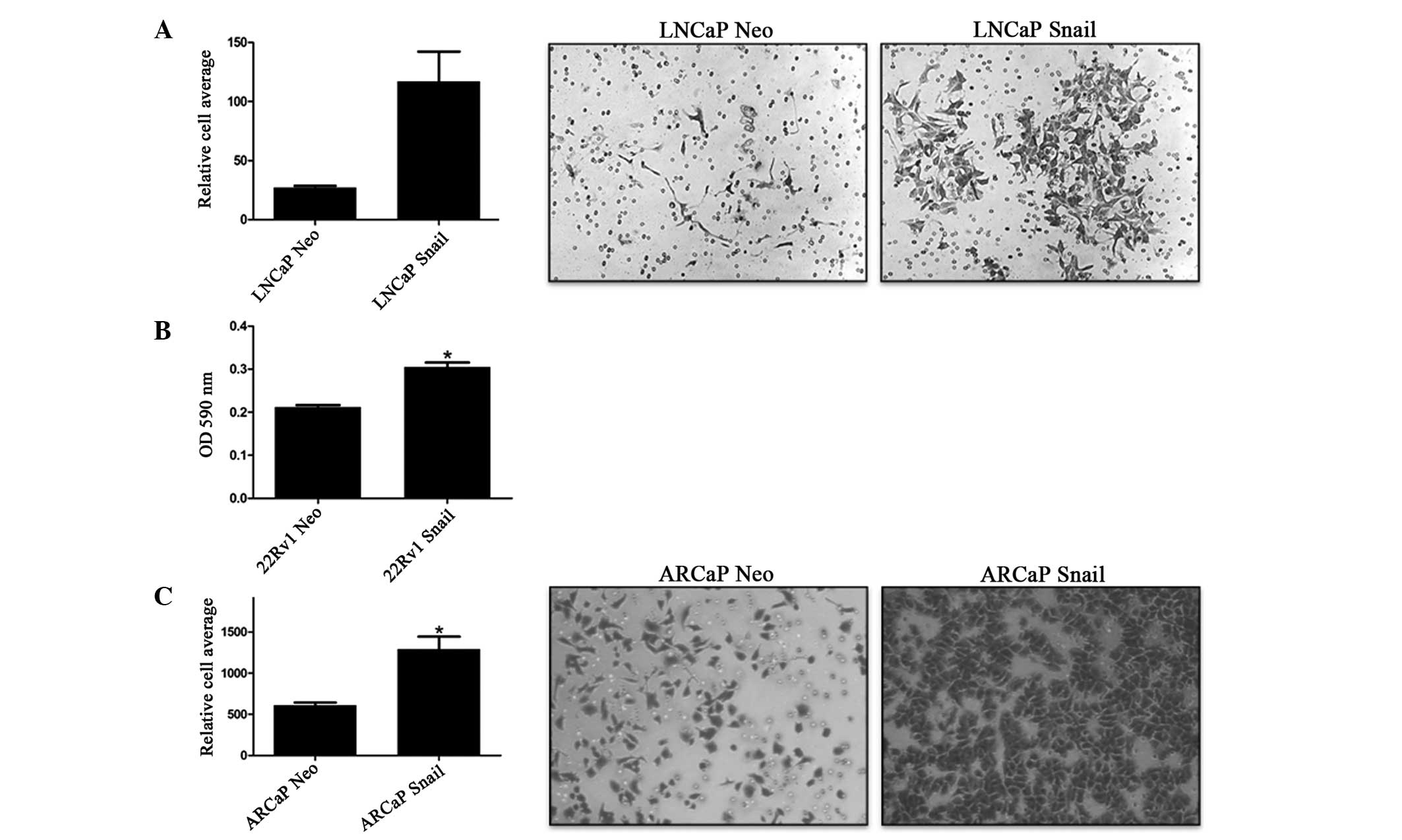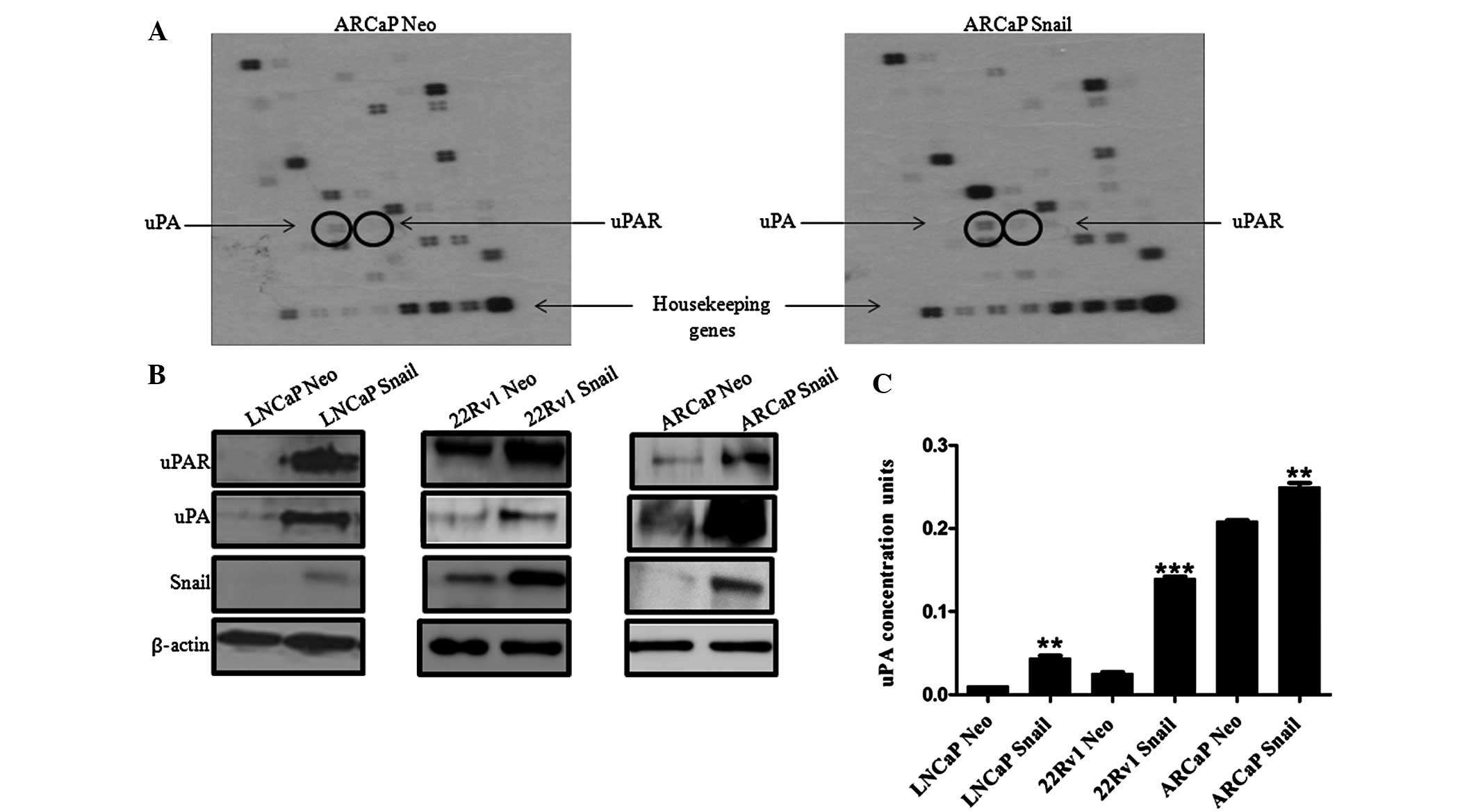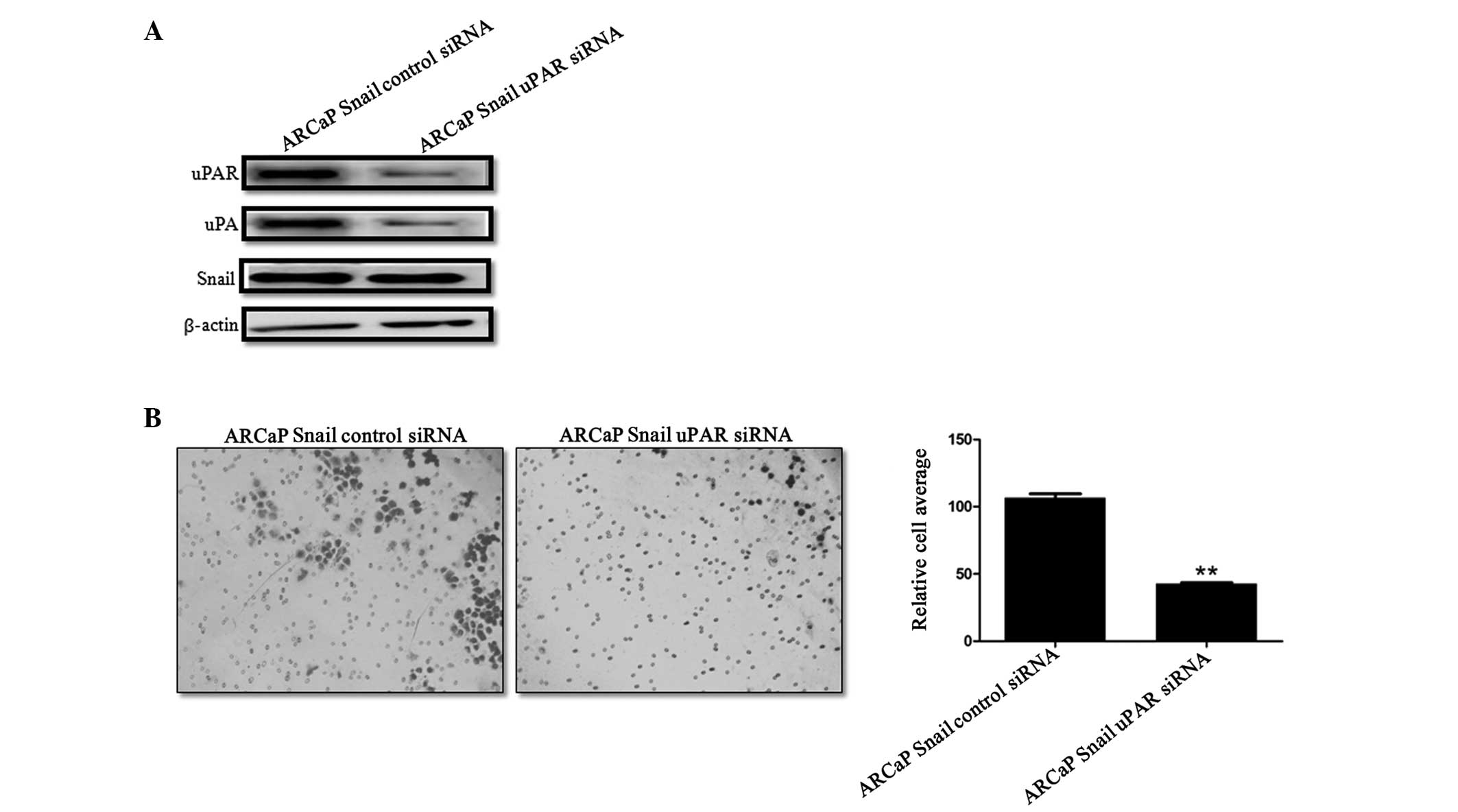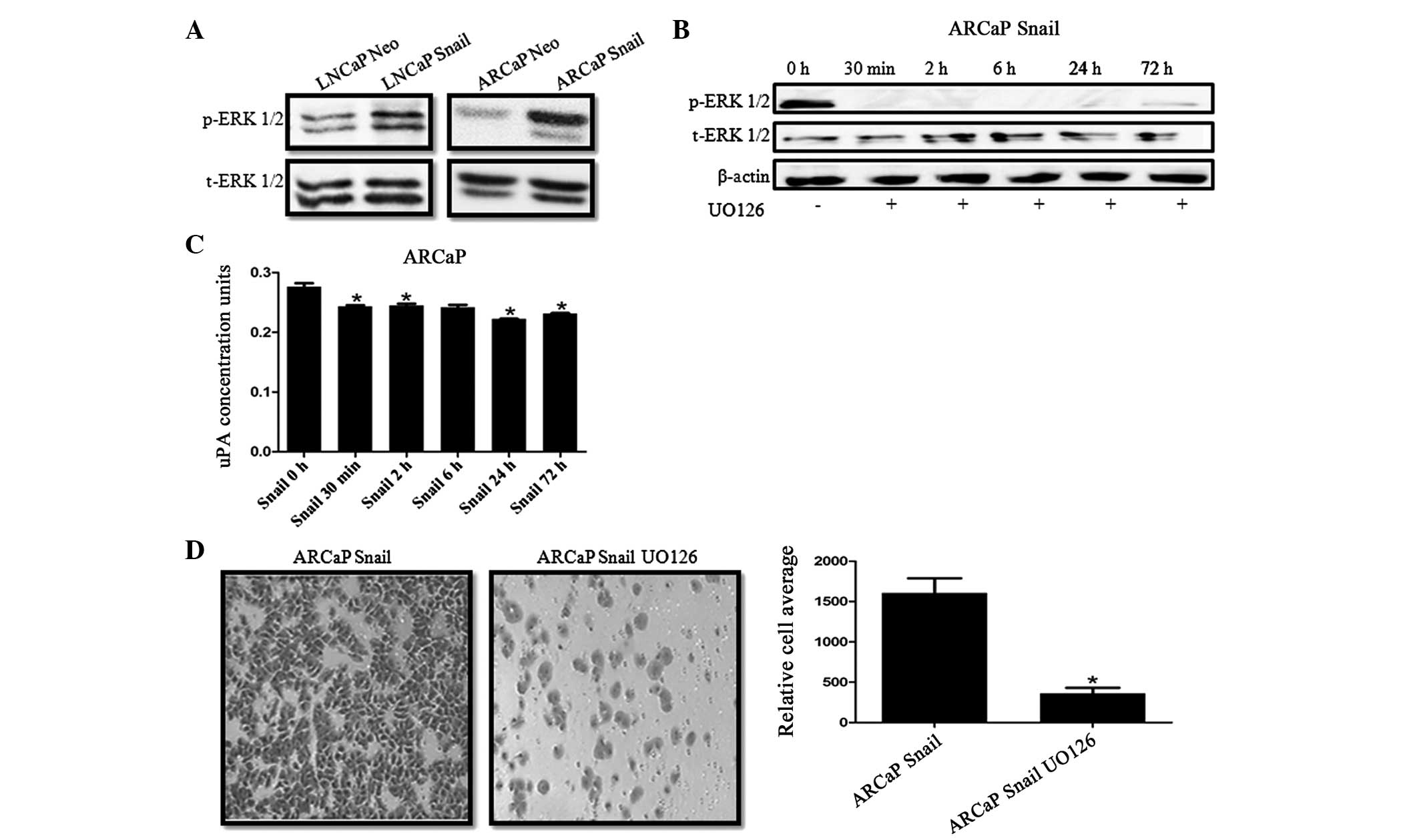|
1
|
Siegel R, Naishadham D and Jemal A: Cancer
statistics, 2012. CA Cancer J Clin. 62:10–29. 2012. View Article : Google Scholar
|
|
2
|
Siegel R, DeSantis C, Virgo K, et al:
Cancer treatment and survivorship statistics, 2012. CA Cancer J
Clin. 62:220–241. 2012. View Article : Google Scholar : PubMed/NCBI
|
|
3
|
Mimeault M and Batra SK: Recent advances
on multiple tumorigenic cascades involved in prostatic cancer
progression and targeting therapies. Carcinogenesis. 27:1–22. 2006.
View Article : Google Scholar : PubMed/NCBI
|
|
4
|
Culig Z, Steiner H, Bartsch G and Hobisch
A: Mechanisms of endocrine therapy-responsive and -unresponsive
prostate tumours. Endocr Relat Cancer. 12:229–244. 2005. View Article : Google Scholar : PubMed/NCBI
|
|
5
|
Clarke NW, Hart CA and Brown MD: Molecular
mechanisms of metastasis in prostate cancer. Asian J Androl.
11:57–67. 2009. View Article : Google Scholar : PubMed/NCBI
|
|
6
|
Chambers AF, MacDonald IC, Schmidt EE, et
al: Steps in tumor metastasis: new concepts from intravital
videomicroscopy. Cancer Metastasis Rev. 14:279–301. 1995.
View Article : Google Scholar : PubMed/NCBI
|
|
7
|
Xu J, Lamouille S and Derynck R:
TGF-beta-induced epithelial to mesenchymal transition. Cell Res.
19:156–172. 2009. View Article : Google Scholar : PubMed/NCBI
|
|
8
|
Jing Y, Han Z, Zhang S, Liu Y and Wei L:
Epithelial-Mesenchymal Transition in tumor microenvironment. Cell
Biosci. 1:292011. View Article : Google Scholar : PubMed/NCBI
|
|
9
|
Larue L and Bellacosa A:
Epithelial-mesenchymal transition in development and cancer: role
of phosphatidylinositol 3′ kinase/AKT pathways. Oncogene.
24:7443–7454. 2005.
|
|
10
|
Cho HJ, Baek KE, Saika S, Jeong MJ and Yoo
J: Snail is required for transforming growth factor-beta-induced
epithelial-mesenchymal transition by activating PI3 kinase/Akt
signal pathway. Biochem Biophys Res Commun. 353:337–343. 2007.
View Article : Google Scholar : PubMed/NCBI
|
|
11
|
Batlle E, Sancho E, Francí C, et al: The
transcription factor snail is a repressor of E-cadherin gene
expression in epithelial tumour cells. Nat Cell Biol. 2:84–89.
2000. View
Article : Google Scholar : PubMed/NCBI
|
|
12
|
Nieto MA: The snail superfamily of
zinc-finger transcription factors. Nat Rev Mol Cell Biol.
3:155–166. 2002. View
Article : Google Scholar : PubMed/NCBI
|
|
13
|
Haraguchi M: The role of the
transcriptional regulator snail in cell detachment, reattachment
and migration. Cell Adh Migr. 3:259–263. 2009. View Article : Google Scholar : PubMed/NCBI
|
|
14
|
Barrallo-Gimeno A and Nieto MA: The Snail
genes as inducers of cell movement and survival: implications in
development and cancer. Development. 132:3151–3161. 2005.
View Article : Google Scholar : PubMed/NCBI
|
|
15
|
Domínguez D, Montserrat-Sentís B,
Virgós-Soler A, et al: Phosphorylation regulates the subcellular
location and activity of the snail transcriptional repressor. Mol
Cell Biol. 23:5078–5089. 2003.PubMed/NCBI
|
|
16
|
Peiró S, Escrivà M, Puig I, et al: Snail1
transcriptional repressor binds to its own promoter and controls
its expression. Nucleic Acids Res. 34:2077–2084. 2006.PubMed/NCBI
|
|
17
|
Peinado H, Ballestar E, Esteller M and
Cano A: Snail mediates E-cadherin repression by the recruitment of
the Sin3A/histone deacetylase 1 (HDAC1)/HDAC2 complex. Mol Cell
Biol. 24:306–319. 2004. View Article : Google Scholar : PubMed/NCBI
|
|
18
|
Heebøll S, Borre M, Ottosen PD, Dyrskjøt
L, Orntoft TF and Tørring N: Snail1 is over-expressed in prostate
cancer. APMIS. 117:196–204. 2009.
|
|
19
|
Dass K, Ahmad A, Azmi AS, Sarkar SH and
Sarkar FH: Evolving role of uPA/uPAR system in human cancers.
Cancer Treat Rev. 34:122–136. 2008. View Article : Google Scholar : PubMed/NCBI
|
|
20
|
Conese M and Blasi F: Urokinase/urokinase
receptor system: internalization/degradation of urokinase-serpin
complexes: mechanism and regulation. Biol Chem Hoppe Seyler.
376:143–155. 1995.PubMed/NCBI
|
|
21
|
Smith HW and Marshall CJ: Regulation of
cell signalling by uPAR. Nat Rev Mol Cell Biol. 11:23–36. 2010.
View Article : Google Scholar : PubMed/NCBI
|
|
22
|
Dong Z, Saliganan AD, Meng H, et al:
Prostate cancer cell-derived urokinase-type plasminogen activator
contributes to intraosseous tumor growth and bone turnover.
Neoplasia. 10:439–449. 2008.PubMed/NCBI
|
|
23
|
Lee KH, Kim SW and Kim JR: Reactive oxygen
species regulate urokinase plasminogen activator expression and
cell invasion via mitogen-activated protein kinase pathways after
treatment with hepatocyte growth factor in stomach cancer cells. J
Exp Clin Cancer Res. 28:732009. View Article : Google Scholar
|
|
24
|
Shariat SF, Roehrborn CG, McConnell JD, et
al: Association of the circulating levels of the urokinase system
of plasminogen activation with the presence of prostate cancer and
invasion, progression, and metastasis. J Clin Oncol. 25:349–355.
2007. View Article : Google Scholar : PubMed/NCBI
|
|
25
|
Mazar AP, Ahn RW and O’Halloran TV:
Development of novel therapeutics targeting the urokinase
plasminogen activator receptor (uPAR) and their translation toward
the clinic. Curr Pharm Des. 17:1970–1978. 2011. View Article : Google Scholar : PubMed/NCBI
|
|
26
|
Jo M, Takimoto S, Montel V and Gonias SL:
The urokinase receptor promotes cancer metastasis independently of
urokinase-type plasminogen activator in mice. Am J Pathol.
175:190–200. 2009. View Article : Google Scholar : PubMed/NCBI
|
|
27
|
Bessard A, Frémin C, Ezan F, Coutant A and
Baffet G: MEK/ERK-dependent uPAR expression is required for
motility via phosphorylation of P70S6K in human hepatocarcinoma
cells. J Cell Physiol. 212:526–536. 2007. View Article : Google Scholar : PubMed/NCBI
|
|
28
|
Baek MK, Kim MH, Jang HJ, et al: EGF
stimulates uPAR expression and cell invasiveness through ERK, AP-1,
and NF-κB signaling in human gastric carcinoma cells. Oncol Rep.
20:1569–1575. 2008.PubMed/NCBI
|
|
29
|
Jordà M, Olmeda D, Vinyals A, et al:
Upregulation of MMP-9 in MDCK epithelial cell line in response to
expression of the Snail transcription factor. J Cell Sci.
118:3371–3385. 2005.PubMed/NCBI
|
|
30
|
Miyoshi A, Kitajima Y, Sumi K, et al:
Snail and SIP1 increase cancer invasion by upregulating MMP family
in hepatocellular carcinoma cells. Br J Cancer. 90:1265–1273. 2004.
View Article : Google Scholar : PubMed/NCBI
|
|
31
|
Yokoyama K, Kamata N, Fujimoto R, et al:
Increased invasion and matrix metalloproteinase-2 expression by
Snail-induced mesenchymal transition in squamous cell carcinomas.
Int J Oncol. 22:891–898. 2003.PubMed/NCBI
|
|
32
|
Jo M, Lester RD, Montel V, Eastman B,
Takimoto S and Gonias SL: Reversibility of epithelial-mesenchymal
transition (EMT) induced in breast cancer cells by activation of
urokinase receptor-dependent cell signaling. J Biol Chem.
284:22825–22833. 2009. View Article : Google Scholar : PubMed/NCBI
|
|
33
|
Fabre-Guillevin E, Malo M, Cartier-Michaud
A, et al: PAI-1 and functional blockade of SNAI1 in breast cancer
cell migration. Breast Cancer Res. 10:R1002008. View Article : Google Scholar : PubMed/NCBI
|
|
34
|
Neal CL, McKeithen D and Odero-Marah VA:
Snail negatively regulates cell adhesion to extracellular matrix
and integrin expression via the MAPK pathway in prostate cancer
cells. Cell Adh Migr. 5:249–257. 2011. View Article : Google Scholar : PubMed/NCBI
|
|
35
|
Neal CL, Henderson V, Smith BN, et al:
Snail transcription factor negatively regulates maspin tumor
suppressor in human prostate cancer cells. BMC Cancer. 12:3362012.
View Article : Google Scholar : PubMed/NCBI
|
|
36
|
Barnett P, Arnold RS, Mezencev R, Chung
LW, Zayzafoon M and Odero-Marah V: Snail-mediated regulation of
reactive oxygen species in ARCaP human prostate cancer cells.
Biochem Biophys Res Commun. 404:34–39. 2011. View Article : Google Scholar : PubMed/NCBI
|
|
37
|
McKeithen D, Graham T, Chung LW and
Odero-Marah V: Snail transcription factor regulates neuroendocrine
differentiation in LNCaP prostate cancer cells. Prostate.
70:982–992. 2010.
|
|
38
|
Pulukuri SM, Gondi CS, Lakka SS, et al:
RNA interference-directed knockdown of urokinase plasminogen
activator and urokinase plasminogen activator receptor inhibits
prostate cancer cell invasion, survival, and tumorigenicity in
vivo. J Biol Chem. 280:36529–36540. 2005. View Article : Google Scholar
|
|
39
|
Alfano D, Iaccarino I and Stoppelli MP:
Urokinase signaling through its receptor protects against anoikis
by increasing BCL-xL expression levels. J Biol Chem.
281:17758–17767. 2006. View Article : Google Scholar : PubMed/NCBI
|
|
40
|
Lester RD, Jo M, Montel V, Takimoto S and
Gonias SL: uPAR induces epithelial-mesenchymal transition in
hypoxic breast cancer cells. J Cell Biol. 178:425–436. 2007.
View Article : Google Scholar : PubMed/NCBI
|


















